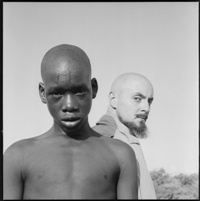Certain tropes of photography, particularly images of half-naked Africans during the colonial era, are always going to be fraught. Essentialism, exploitation, the other, racismyou’ll hear all those terms both whispered and shouted. But because they’re problematic, and gorgeous, the large black-and-white photos in Hector Acebes: Portraits in Africa, 1948-1953 are worth seeing. (Marquand’s 2004 monograph of the same name contains more such images.) These portraits should make you somewhat uncomfortable, though the New York-born photographer, now 90 years old and living in Colombia, was traveling in a very different time. Trained as an engineer, he became an ethnodocumentary filmmaker while also shooting stills in Africa and Latin America. His subjects are clearly posed, like the Native Americans photographed by the Curtis brothers, but without anachronistic costumes. They seem apart, dignified, but not demeaned by their exotic distance from Western eyes. Unlike Cartier-Bresson, Acebes didn’t shoot in 35mm, stealing his decisive moments on the fly. He instead used a medium-format Rolleiflex camera, where you deliberately peer down to frame and focus, then can look up to make eye contact with the subject. There’s more of an agreement involved, though no consent forms were ever signed. The imbalance of power between a roving photographer and a bare-breasted African woman can never be rectified. Fifty years later, a topless black fashion model would be paid to appear in Vogue, but I prefer Acebes’ transaction. BRIAN MILLER
Thu., Sept. 1, 5-7 p.m.; Fridays, 2-6 p.m.; Saturdays, 11 a.m.-6 p.m. Starts: Sept. 1. Continues through Oct. 5, 2011




